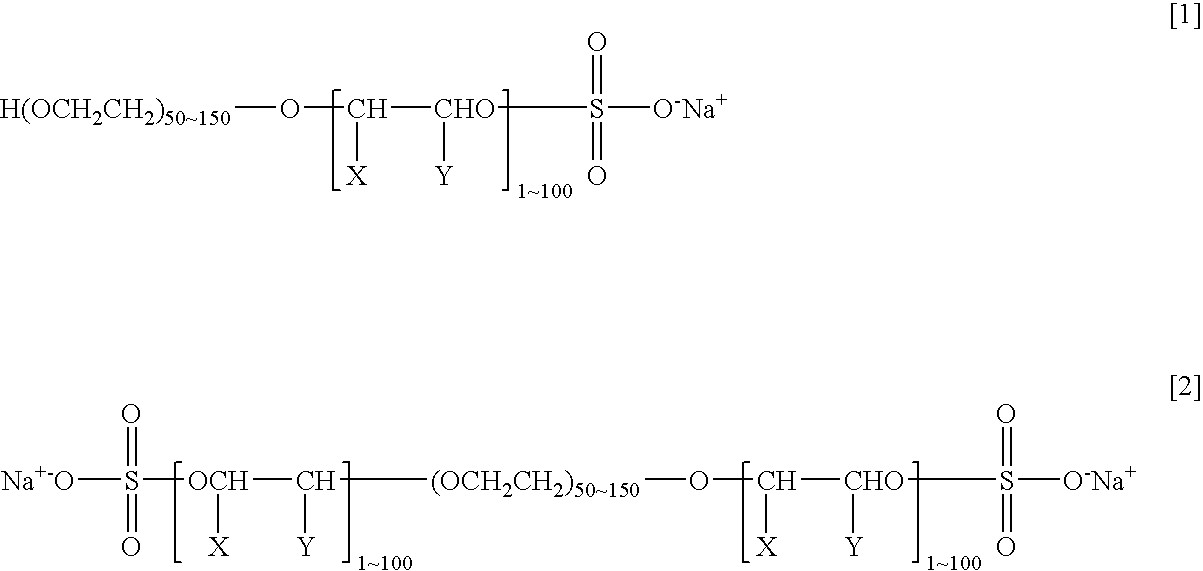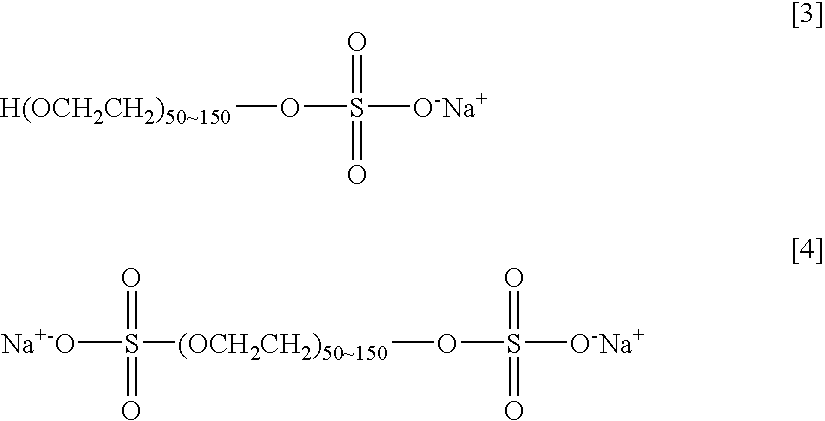Agent and Process for Increasing Rejection of Nanofiltration Membrane or Reverse Osmosis Membrane, Nanofiltration Membrane or Reverse Osmosis Membrane, Process for Water Treatment and Apparatus for Water Treatment
a technology of nanofiltration membrane and reverse osmosis membrane, which is applied in the direction of membranes, separation processes, filtration separation, etc., can solve the problems of reducing the quality of treated water, difficult to remove nonionic organic low molecular weight compounds such as urea and isopropyl alcohol, and difficult to obtain the required quality of treated water. , to achieve the effect of increasing the rejection, increasing the rejection, and decreasing the flux
- Summary
- Abstract
- Description
- Claims
- Application Information
AI Technical Summary
Benefits of technology
Problems solved by technology
Method used
Image
Examples
example 1
[0043]The relations of the weight-average molecular weight of polyethylene glycol with the flux and the rejection were examined using an aqueous solution of urea.
[0044]A reverse osmosis membrane [manufactured by NITTO DENKO Co., Ltd,; ES20] was disposed on a flat membrane cell having an area of the membrane of 8 cm2. An aqueous solution of urea having a concentration of 50 mg / liter was passed through the cell under a pressure of 0.75 MPa. The flux was 1.024 m3 / (m2·d), and the rejection was 0.154.
[0045]An aqueous solution containing polyethylene glycol having a weight-average molecular weight of 400 in a concentration of 1 mg / liter was passed through the flat membrane cell in which the reverse osmosis membrane was disposed as described above under a pressure of 0.75 MPa for 20 hours and, then, an aqueous solution of urea having a concentration of 50 mg / liter was passed through the cell under a pressure of 0.75 MPa. The flux was 1.087 m3 / (m2·d), and the rejection was 0.148.
[0046]The s...
example 2
[0052]In the treatment with polyethylene glycol or sulfonated polyethylene glycol, the flux and the rejection were examined using an aqueous solution of isopropyl alcohol.
[0053]A reverse osmosis membrane [manufactured by NITTO DENKO Co., Ltd,; ES20] was disposed on a flat membrane cell having an area of the membrane of 8 cm2. An aqueous solution of isopropyl alcohol having a concentration of 300 mg / liter was passed through the cell under a pressure of 0.75 MPa. The flux was 1.069 m3 / (m2·d), and the rejection was 0.778.
[0054]An aqueous solution containing polyethylene glycol having a weight-average molecular weight of 4,000 in a concentration of 1 mg / liter was passed through the flat membrane cell in which the reverse osmosis membrane was disposed as described above under a pressure of 0.75 MPa for 20 hours and, then, an aqueous solution of isopropyl alcohol having a concentration of 300 mg / liter was passed through the cell under a pressure of 0.75 MPa. The flux was 0.624 m3 / (m2·d), ...
example 3
[0056]The same procedures as those conducted in Example 2 were conducted except that an aqueous solution of sodium chloride having a concentration of 500 mg / liter was used in place of the aqueous solution of isopropyl alcohol having a concentration of 300 mg / liter.
[0057]The flux was 0.955 m3 / (m2·d), and the rejection was 0.971 when no aqueous solution of a polymer was passed through the reverse osmosis membrane. The flux was 0.589 m3 / (m2·d), and the rejection was 0.978 when the aqueous solution of polyethylene glycol was passed through the reverse osmosis membrane. The flux was 0.619 m3 / (m2·d), and the rejection was 0.986 when the aqueous solution of the sulfonated polyethylene glycol was passed through the reverse osmosis membrane.
[0058]The results of Examples 2 and 3 are shown in Table 2.
TABLE 2Weight-averagemolecularWater forFluxPolymerweighttreatment(m3 / m2 · d)RejectionExample 2none—aqueous1.0690.778PEG4000solution of0.6240.879sulfonated4000IPA, 3000.7290.804PEGmg / literExample 3...
PUM
| Property | Measurement | Unit |
|---|---|---|
| pressure | aaaaa | aaaaa |
| particle diameter | aaaaa | aaaaa |
| time | aaaaa | aaaaa |
Abstract
Description
Claims
Application Information
 Login to View More
Login to View More - R&D
- Intellectual Property
- Life Sciences
- Materials
- Tech Scout
- Unparalleled Data Quality
- Higher Quality Content
- 60% Fewer Hallucinations
Browse by: Latest US Patents, China's latest patents, Technical Efficacy Thesaurus, Application Domain, Technology Topic, Popular Technical Reports.
© 2025 PatSnap. All rights reserved.Legal|Privacy policy|Modern Slavery Act Transparency Statement|Sitemap|About US| Contact US: help@patsnap.com


